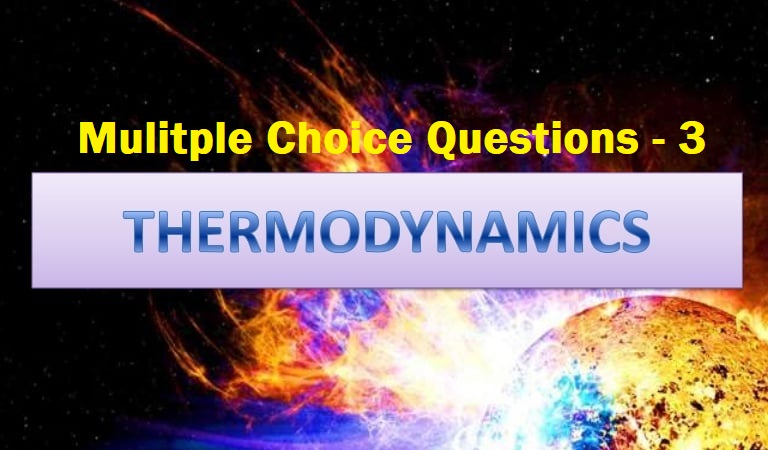CBSE Class 11 Chemistry Chapter 6 Thermodynamics Multiple Choice Questions with Answers. MCQ Questions Class 11 Chemistry Thermodynamics with Answers was Prepared Based on Latest Exam Pattern. Students can solve NCERT Class 11 Chemistry Thermodynamics MCQs with Answers to know their preparation level.
Students who are searching for NCERT MCQ Questions for Class 11 Chemistry Thermodynamics with Answers are compiled here to get good practice on all fundamentals. Know your preparation level on MCQ Questions for Class 11 Chemistry with Answers. You can also verify your answers from our provided MCQ Class 11 Chemistry Thermodynamics with Answers. So, ace up your preparation with MCQ of Chapter 6 Chemistry Objective Questions.
MCQ Questions Class 11 Chemistry Thermodynamics with Answers - Set - 3
Question 1:
The heat required to raise the temperature of a body by 1 K is called
(a) Specific heat
(b) Thermal capacity
(c) Water equivalent
(d) Molar heat capacity
Correct Answer – (B)
Question 2 :
For which one of the following equations AHreaction equals ∆H0f for the product?
(a) N2(g) + O3(g) → N2O3(g)
(b) CH4(g) + 2Cl2(g) → CH2Cl2(l) + 2HCl(g)
(c) Xe(g) + 2F2(g) → XeF4(g)
(d) 2C(g) + O2(g) → 2CO2(g)
Correct Answer – (C)
Question 3 :
Molar heat capacity of water in equilibrium with ice at constant pressure is
(a) zero
(b) infinity
(c) 40.45 kj K-1 mol-1
(d) 75.48 JK-1 mol-1
Correct Answer – (B)
Question 4 :
One mole of a hon-ideal gas undergoes a change of state (2.0 atm, 3.0 L, 95 K) → (4.0 atm, 5.0 L, 245 K) with a change in internal energy, ∆U = 30.0 L atm. The change in enthalpy (∆H) of the process in L atm is
(a) 44.0
(b) 42.3
(c) 44.0
(d) not defined because pressure is not constant.
Correct Answer – (c)
Question 5 :
The bond energies of C-C, C=C; H-H and C-H linkages are 350, 600, 400 and 410 kj per mole respectively. The heat of hydrogenation of ethylene is
(a) -170 kj mol-1
(b) -260 kj mol-1
(c) 400 kj mol-1
(d) -450 kj mol-1
Correct Answer – (A)
MCQ Questions Class 11 Chemistry Thermodynamics with Answers
Question 6 :
Enthalpy of CH4 + 12 O2 → CH3OH is negative.
If enthalpy of combustion of CH4 and CH3OH are x and y respectively then which reaction is correct?
(a) x > y
(b) x < y
(c) x = y
(d) x ≥ y
Correct Answer – (B)
Question 7 :
For the reaction C3H8(g) + 5O2(g) → 3CO2(g) + 4H2O(I) at constant temperature ∆H – ∆E is
(a) + RT
(b) – 3RT
(c) + 3RT
(d) -RT
Correct Answer – (B)
Question 8 :
Which one of the following statement is false?
(a) Work is a state function
(b) Temperature is a state function
(c) Change in the state is completely defined when the initial final states are specified
(d) Work appears at the boundary of the system
Correct Answer – (A)
Question 9 :
(a) C(Diamond) + O2(g) → CO2(g)
(b) ½H2(g) + ½ F2(g) → HF(g)
(c) N2(g) + 3H2(g) → 2NH3(g)
(d) CO(g) + ½ O2(g) → CO2(g)
Correct Answer – (B)
Question 10 :
AHr of graphite is 0.23 kj/mol and ∆Hf for diamond is 1.896 kj mol-1, ∆Htransition from graphite to diamond is
(a) 1.66 kj/mol
(b) 2.1 kj/mol
(c) 2.33 kj/mol
(d) 1.5 kj/mol
Correct Answer – (A)
- NCERT Solutions Class 11 Chemistry Chapter 1 : Some Basic Concepts of Chemistry
- NCERT Solutions Class 11 Chemistry Chapter 2 : Structure Of The Atom
- NCERT Solutions Class 11 Chemistry Chapter 3 : Classification of Elements and Periodicity in Properties
- NCERT Solutions Class 11 Chemistry Chapter 4 : Chemical Bonding and Molecular Structure
- NCERT Solutions Class 11 Chemistry Chapter 5 : States of Matter
- NCERT Solutions Class 11 Chemistry Chapter 6 : Thermodynamics
- NCERT Solutions Class 11 Chemistry Chapter 7 : Equilibrium
- NCERT Solutions Class 11 Chemistry Chapter 8 : Redox Reactions
- NCERT Solutions Class 11 Chemistry Chapter 9 : Hydrogen
- NCERT Solutions Class 11 Chemistry Chapter 10 : The s-Block Elements
- NCERT Solutions Class 11 Chemistry Chapter 11 : The p-Block Elements
- NCERT Solutions Class 11 Chemistry Chapter 12 : Organic Chemistry: Some Basic Principles and Techniques
- NCERT Solutions Class 11 Chemistry Chapter 13 : Hydrocarbons
- NCERT Solutions Class 11 Chemistry Chapter 14 : Environmental Chemistry



